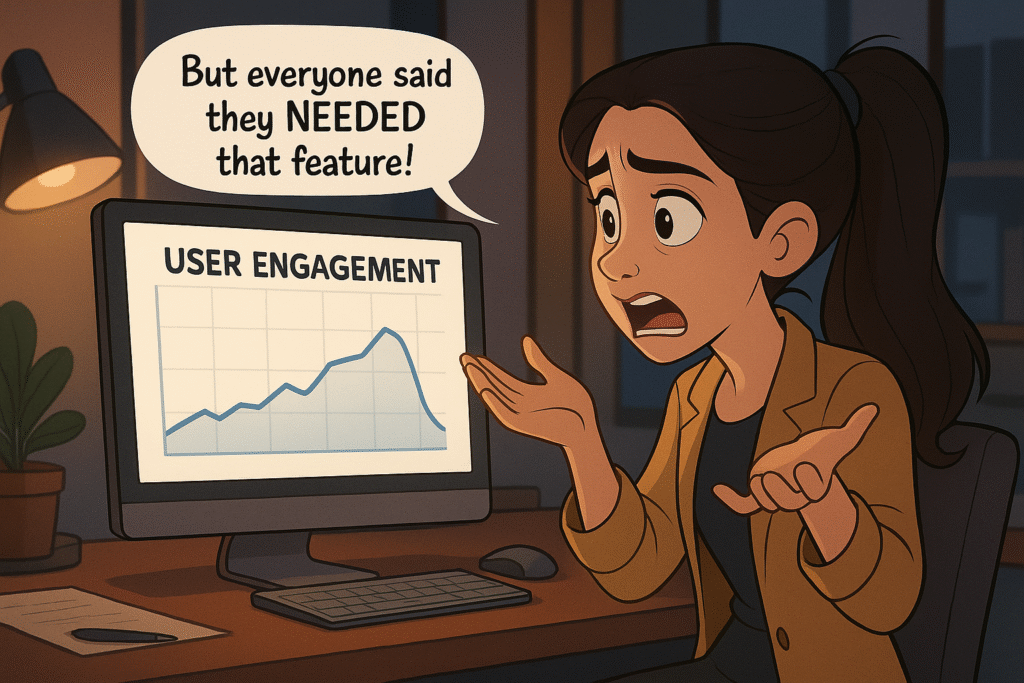
The behavioral data revolution that’s reshaping product strategy
Three months ago, a SaaS founder emailed me, clearly in a panic.
Her Net Promoter Score had never been higher — 73, well above industry average.
Customer satisfaction surveys glowed with praise.
Retention looked solid based on stated loyalty metrics.
Then their churn rate suddenly spiked to 18%.
“Our customers love us,” the founder insisted. “The data proves it.”
That’s when she had to face the unsettling, somewhat weird truth: 75% of companies cannot use Net Promoter Score as an accurate predictor of customer churn.
The satisfaction surveys were measuring aspirational loyalty while actual behavior told a completely different story.
Smart companies have stopped making this mistake.
Unbounce achieved an 11% cancellation deflection rate by implementing dynamic churn surveys at the point of cancellation — discovering that customers’ REAL cancellation reasons differed dramatically from their responses in periodic satisfaction surveys.
The breakthrough wasn’t really better surveys. It was in capturing behavior at the moment of truth.
Apple TV+ learned this lesson expensively. Despite maintaining high content satisfaction ratings, churn increased from 5.5% to 6.4% following a 40% price increase.
Industry data showed 66% of streaming subscribers canceled services DESPITE satisfaction with content quality.
The budget impact of yet another streaming service just didn’t justify the overall value.
The pattern emerges everywhere: satisfaction scores miss the complex relationship between customer value and retention likelihood.
There are a lot of moving parts inside your customer’s lives and minds. More than ever at a time like this.
CustomerGauge‘s analysis revealed the “high-value customer paradox” — revenue contribution didn’t correlate with satisfaction scores. Promoters made up 40% of highest-value customers, but detractors still represented 24% of the high-value segment.
The companies winning this behavioral revolution share three strategies:
They capture data at decision moments. Instead of quarterly surveys, they track behavior during purchase, usage, and cancellation decisions.
They weight revealed preferences over stated ones. What customers do with their time and money matters more than what they claim matters to them.
They test with real consequences. Pilot programs with actual commitment reveal truth (and realistic trade-offs) that hypothetical scenarios cannot.
In I Need That, I emphasize how validation requires moving beyond opinions to observe actual behavior. The most successful products emerge from understanding what people genuinely need — not what they think they should need, or feel comfortable saying.
Product Payoff: by ignoring stated preferences for formal business tools and instead tracking actual usage patterns, Slack transformed enterprise communication. While Teams scored higher in satisfaction surveys, behavioral data showed 92% of engaged Slack users utilized group messaging versus only 11% for Teams.
So, by prioritizing engagement metrics over satisfaction scores, Slack built features that drove real workplace adoption rather than survey-friendly functionality that sat unused.
Your strategic shift: Replace one major survey-based decision this quarter with behavioral testing. Create scenarios where customers reveal preferences through actions rather than words.
Track what folks choose when convenience, price, and complete real-world trade-offs are involved.
This concludes my three-part series on the say-do gap that’s reshaping how smart companies make decisions.
We’ve seen how sustainability claims mislead product strategies, why user complaints often signal engagement rather than problems, and how behavioral data reveals customer truth that surveys completely miss.
The companies thriving in this new reality share ONE insight:
They’ve stopped asking customers what they want and started watching what they actually choose.
Every successful product I’ve worked with at Graphos Product follows this principle — validation through demonstrated behavior, not only surveys.
The say-do gap isn’t going away — but companies that recognize and adapt to it are building sustainable competitive advantages while competitors chase survey mirages.
What’s the biggest gap you’ve discovered between what customers told you and what they actually did?
Tap that reply arrow and share your own behavioral insight discoveries.
Or reach out to my team of product validation specialists at Graphos Product.
